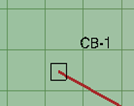Catch Basins in 2D Solver
When computing with the 2D Solver, Catch Basins are coupled with the grid if they overlap any grid cells. Directed surface flow paths are modelled with a 2D grid instead of discrete gutter links. Inlet capture calculations are performed in 2D, although differently.
The entire approaching gutter flow is evaluated at the inlet opening when computing bypass for an on-grade inlet during a 1D simulation. However, the influx corresponding to the one computational grid cell at the inlet opening is used to estimate the amount of capture. An underestimation of capture could occur if the grate or curb length is larger than the dimensions of a grid cell. Bypass is no longer a directed flow, as any uncaptured surface flow on grid may continue to pool or continue downstream two dimensionally.
Elevation adjustments for coupled inlets relative to the grid become paramount in computing inlet capture. The option of Adjust Rim to Grid, or Adjust Grid to Rim is useful in accurately simulating the localized ground elevation, depressed, or perched structures.
During surface flooding, inlet capture is more likely governed by the available storage of the 1D drainage network than the hydraulic capacity of the inlet opening. When the subsurface system is overwhelmed, upwelling could occur onto the grid and yielding non-applicable capture results. More useful that the nominal capture amounts, and derived efficiency at each structure, are the local maximums. Noting the times of maximum surface flow or minimum capture efficiency, or noting maximum inflow and overflow, could be the most informative in identifying bottlenecks in the 1D-2D system.

